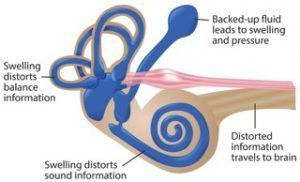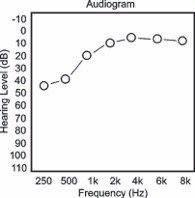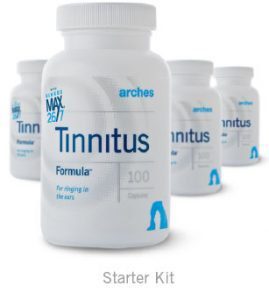By Barry Keate
Barry Keate, has lived with tinnitus over 40 years and has published 150+ research articles on numerous aspects of tinnitus. He is an expert on the condition and a well-known advocate for those with tinnitus.
Meniere’s disease is of unknown (idiopathic) origin, so treatment is difficult. It is recognized by a combination of symptoms: extreme vertigo, progressive hearing loss, tinnitus and ear fullness. The good news is that our understanding of the disease has recently increased, and there is a new treatment which consistently produces positive results.
The new treatment comes to us through Neil Bauman, PhD, who is founder and director of the Center for Hearing Loss Help. He suffers from hereditary hearing loss and tinnitus. He has devoted his life to hearing loss research and has written extensively, including several books. In the process, he has found an upper cervical chiropractor who has successfully treated more than 530 patients with Meniere’s disease.
I’ll summarize the new procedure here and also provide a link below, for readers who want to purchase Dr. Bauman’s book, Say Good Bye to Meniere’s Disease (1). But first let’s consider what is already commonly known about Meniere’s disease – again relying on Dr. Bauman’s book.
What is Meniere’s Disease?
Meniere’s disease has been known for more than 150 years. Diagnosis is by a process of elimination. It involves testing for all other conditions that resemble Meniere’s. When other causes are excluded, the remaining diagnosis is Meniere’s disease.
Estimates vary, but in the US perhaps two people in 1000 suffer from Meniere’s; that works out to over 600,000 people. In Canada estimates are about three times higher, but these differences probably result from the difficulty in diagnosis.
Meniere’s is caused by excess endolymph fluid (Endolymphatic Hydrops) in the inner ear’s vestibular chamber. No one knows whether this is due to over-production or under-absorption – and some scientists have begun to view the excess fluid itself as a symptom, not a cause. (See our previous article on Meniere’s disease for details about diagnosis. )
 The vestibular chamber, along with the cochlea, is part of the auditory system. Endolymph reacts with its electrical opposite, perilymph, sending electrical signals to the brain and affecting balance, spatial orientation and eye movement. Excess endolymph increases the pressure inside the chamber, rupturing the membrane which separates the two fluids. When they mix, they short-circuit the system. This wreaks havoc with signal processing, causing several major symptoms.
The vestibular chamber, along with the cochlea, is part of the auditory system. Endolymph reacts with its electrical opposite, perilymph, sending electrical signals to the brain and affecting balance, spatial orientation and eye movement. Excess endolymph increases the pressure inside the chamber, rupturing the membrane which separates the two fluids. When they mix, they short-circuit the system. This wreaks havoc with signal processing, causing several major symptoms.
Meniere’s disease has four classic symptoms:
1 – Vertigo is the primary and most distressing symptom. This is the perception of the world spinning uncontrollably. It may be serious enough to force the person to lie down, and severe attacks may cause a person to drop suddenly to the floor. These “drop attacks” leave a person helpless and may induce severe vomiting.
Attacks may last a few minutes or go on for hours. Many never experience severe drop attacks. Some get them frequently, others only once every year or two.
About 70% of people with Meniere’s find that their vertigo attacks diminish over time. The other 30% experience unrelenting vertigo and may choose aggressive medical therapy such as surgery, or drugs that disable part of the vestibular system.
 2 – Hearing Loss with Meniere’s is usually experienced as fluctuating sensorineural hearing loss. It typically shows up first in the lower frequencies, with an audiogram often showing mild or moderate low-frequency hearing loss. In most cases the loss will eventually affect all frequencies.
2 – Hearing Loss with Meniere’s is usually experienced as fluctuating sensorineural hearing loss. It typically shows up first in the lower frequencies, with an audiogram often showing mild or moderate low-frequency hearing loss. In most cases the loss will eventually affect all frequencies.
Hearing may improve between attacks but worsen with each succeeding attack. Meniere’s seldom causes total deafness, but hearing loss may eventually become severe or profound.
3 – Tinnitus is typically a low-pitched hissing, rushing or roaring noise rather than a high-pitched ringing. This is because the initial hearing loss is low-frequency, and tinnitus occurs at frequencies where hearing is damaged. Tinnitus may or may not fluctuate or disappear between attacks.
4 – Ear Fullness, or pressure in the ear or head, is another major symptom of Meniere’s. The ear feels plugged, as if it needs to pop. The person feels the need to swallow to equalize air pressure, but this doesn’t work. At this point the Eustachian tube is not working properly and cannot equalize pressure.
Other symptoms of Meniere’s may include anxiety, emotional problems, depression, fatigue and muscular aches and pains.
New Treatment for Meniere’s Disease
The new treatment involves the upper cervical spine. In 1999 upper cervical chiropractor Dr. Michael Burcon made an exciting discovery. He was treating the upper cervical area of three patients who also had Meniere’s disease. After treatment, all three patients reported recovery from the vertigo caused by Meniere’s.
Intrigued, Dr. Burcon began documenting cases of Meniere’s disease that presented to him. He soon realized that they had something in common: evidence of neck trauma, specifically whiplash. He began treating all Meniere’s cases as if treating whiplash. To date he has successfully treated more than 530 cases of Meniere’s. In each case, vertigo dramatically improved.
The Upper Cervical Spine
 The neck has seven vertebrae, numbered C1 through C7. The head sits directly on C1, which is often called the “atlas” because of the difficult job of holding the entire head. The head typically weighs 10 or 11 lbs.; the donut-shaped atlas vertebra weighs two ounces. The atlas is also called the “yes bone,” because it allows the head to rock forward and back, as when nodding.
The neck has seven vertebrae, numbered C1 through C7. The head sits directly on C1, which is often called the “atlas” because of the difficult job of holding the entire head. The head typically weighs 10 or 11 lbs.; the donut-shaped atlas vertebra weighs two ounces. The atlas is also called the “yes bone,” because it allows the head to rock forward and back, as when nodding.
C2 is called the “axis” or the “no bone.” It allows the head to turn left and right.
The atlas and axis are the only two vertebrae which do not have an intra-vertebral disc between them. This makes them the two most moveable vertebrae and the two most commonly misaligned.
The brainstem actually extends down into a cavity within the atlas and axis vertebrae, so the spinal cord begins at C3. If C1 and C2 are out of alignment, they put pressure on the base of the brainstem, sometimes with serious consequences. They may interfere with the free flow of nerve signals up and down the nervous system. As Dr. Burcon explains, “Five of the twelve cranial nerves originate in the brainstem. The base of the brain controls many important bodily functions, such as breathing, blood pressure, sleep and balance.”
When C1 or C2 misalignment occurs, the weight of the head is no longer balanced evenly on the atlas vertebrae. When it is not centered, the rest of the body compensates. One shoulder drops and one hip comes up, bringing a leg up with it and creating imbalance in the body. One leg appears shorter than the other, and the person does not walk with a normal gait. This also creates a problem with the back.
C1 misalignment can irritate, constrict or disrupt vital nerve signals to any portion of the body. This can cause muscle or joint pain, including lower back pain; organ dysfunction; reduced immune system function; Meniere’s disease; and other conditions not normally associated with neck problems. There is also a connection with trigeminal neuralgia, a condition which causes serious facial pain and which is often associated with whiplash. The fifth cranial nerve is the trigeminal nerve; its dysfunction causes the Eustachian tube to malfunction, causing the feeling of fullness associated with Meniere’s.
The reason this has been overlooked for so long is that there is a long latency period between neck injuries and the onset of Meniere’s and other symptoms. This period averages 15 years, but can be as long as 25 years. Typically, people are diagnosed with Meniere’s in middle age, but their injury happened many years before, during their high school or college years.
The results of Dr. Burcon’s treatment are dramatic over time. Long-term improvements after initial treatment have been clinically documented in 90% of cases. On a scale of zero to ten, with ten being the worst vertigo, 470 patients in a trial rated their vertigo at an average of 7.8 before treatment. Six weeks after initial treatment, the rating fell to 2.8. At one year, ratings dropped to 1.8 and after two years they were down to 1.2. After three years rating dropped to less than 0.1.
Upper Cervical Chiropractor Training
Conventional chiropractors earn a four-year degree, then pursue a four-year doctoral program in chiropractic (DC). Upper cervical chiropractors have an additional year of post-doctoral study in upper cervical spine treatment techniques, plus associated clinical training. Only about 2% of chiropractors receive post-doctoral training. So upper cervical chiropractors are relatively rare, but they are scattered across the US.
Upper cervical treatments utilize very specific, mostly gentle approaches to measure and adjust displacements in the upper cervical vertebrae. They do not manipulate the neck as they would the lower spine. There is no twisting or cracking, just simple adjustments that are painless and non-invasive.
Engineer Greg Buchanan suffered whiplash after a particularly hard tackle while playing rugby in Australia. He suffered numerous side-effects, including vertigo, tinnitus, a feeling of fullness in his ear, and hearing loss. He eventually found an upper cervical chiropractor who adjusted his C1 and C2 vertebrae and essentially cured his condition. He maintains a website (http://www.upcspine.com) where he lists upper cervical chiropractors around the world. For example, there are 17 of them among the small population of my state, Utah.
What about Hearing Loss and Tinnitus after Therapy?
Dr. Bauman’s book focuses mostly on vertigo. He does not probe hearing loss and tinnitus deeply. So I emailed him a question. His response was gracious and detailed.
Essentially, he said that when the axis (C2) is the point of misalignment, hearing loss, ear fullness and tinnitus are the major symptoms. When the alignment is corrected, some hearing loss returns and the tinnitus improves.
He continues, “However, if the hair cells are already dead – and that does happen with Meniere’s – then hearing will not return. But it seems that sometimes some hair cells die and others are just “sick” – and when the adjustment is made, the sick ones start working properly again and thus that part of hearing does return. The thing is that you do not want to get people’s hopes up that their hearing WILL return. It may (and sometimes does) return to some degree or other, but that is not a given.
“Likewise with tinnitus. If the nerve being pinched is the main cause of the tinnitus, then getting the axis properly aligned will typically result in much of the tinnitus going away. However, if the main cause of the tinnitus is related to hearing loss, then unless hearing also returns with treatment, the tinnitus will generally remain, but it may be less.”
This tells me that early intervention will have better results, but even after many years of misalignment there is hope that some hearing will return and tinnitus will decrease.
Those who still experience a degree of hearing loss and tinnitus after treatment may find further help in the form of Arches Tinnitus Formula with Ginkgo Max 26/7. Clinical studies have shown that ATF reduces tinnitus for the great majority of people who use it, especially those whose tinnitus is due to hearing loss.
Manhattan Ear, Nose and Throat specialist Darius Kohan, MD, has separated his tinnitus patients into those who have it due to hearing loss and those who have it from other causes. He states, “Arches Tinnitus Formula doesn’t work with everybody, but it works with 75% to 80% of these patients (with hearing loss). Arches Tinnitus Formula is a safe and benign treatment that we initiate for patients”.
Though Dr. Bauman’s book focuses on vertigo and is filled with helpful ideas for reducing it, he also examines many other conditions caused by the misalignment of C1 and C2 vertebrae, as well as dietary, environmental, and other triggers for Meniere’s. Purchase the book at his website: http://hearinglosshelp.com/shop/say-good-bye-to-menieres-disease/
References:
1 – “Say Good Bye to Meniere’s Disease – Here’s How to Make Your World Stop Spinning”, Fourth Edition, by Neil G. Bauman. Integrity First Publications, Stewartstown, PA. http://www.IntegrityFirstPublications.com.

